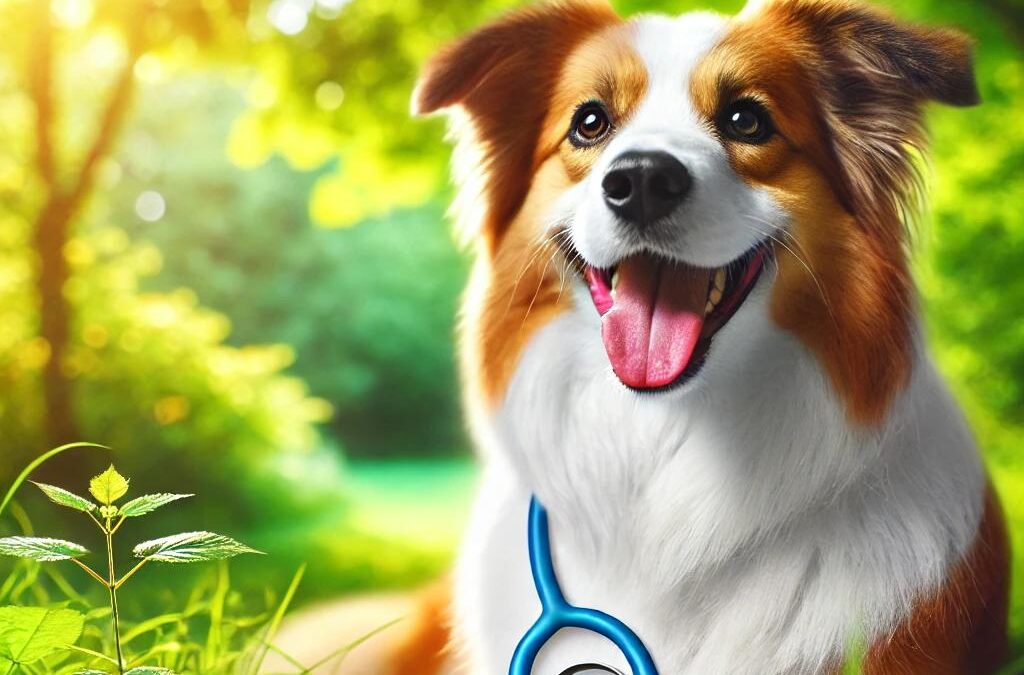
utworzone przez TCMVET | paź 10, 2024 | Rak i guzy u psów
Guzy kręgosłupa są poważnym, ale rzadkim problemem zdrowotnym u psów, który może prowadzić do znacznego dyskomfortu i problemów z poruszaniem się. Zrozumienie natury tych guzów, ich objawów i dostępnych metod diagnostycznych jest niezbędne dla właścicieli zwierząt domowych. Niniejszy przewodnik ma na celu przedstawienie przeglądu guzów kręgosłupa u psów i tego, co możesz zrobić, jeśli podejrzewasz, że Twój pies może być dotknięty chorobą.
Czym są guzy kręgosłupa?
Guzy kręgosłupa mogą występować w różnych formach, albo powstają w samym rdzeniu kręgowym, albo rozwijają się w otaczających kościach. Guzy te mogą pochodzić z tkanki nerwowej, kości lub chrząstki i mogą być klasyfikowane jako guzy pierwotne (pochodzące z kręgosłupa) lub guzy wtórne (guzy przerzutowe, które rozprzestrzeniają się z innych obszarów ciała). Choć rzadkie, guzy te mogą znacząco wpłynąć na jakość życia Twojego psa.
Rozpoznawanie objawów
Objawy guzów kręgosłupa u psów często pokrywają się z objawami innych schorzeń kręgosłupa, takich jak choroba krążka międzykręgowego (IVDD). Oto kilka typowych objawów, na które należy zwrócić uwagę:
- Uporczywy ból:U psów mogą występować objawy bólu, takie jak skomlenie, wycie lub niechęć do ruchu lub zabawy.
- Osłabienie lub paraliż:Trudności z chodzeniem, skakaniem lub staniem mogą wskazywać na osłabienie kończyn.
- Utrata koordynacji:U psów mogą wystąpić objawy chwiejności lub trudności z utrzymaniem równowagi.
- Zmiany behawioralne: Zwiększona drażliwość, letarg lub wycofanie się z normalnych czynności mogą być objawami dyskomfortu.
Diagnoza: Jak wykrywa się guzy kręgosłupa?
Diagnozowanie guzów kręgosłupa wymaga zaawansowanych technik obrazowania, ponieważ ich objawy mogą przypominać objawy IVDD i innych problemów kręgosłupa. Twój weterynarz może zastosować następujące metody diagnostyczne:
- Promienie rentgenowskie:Choć zdjęcia rentgenowskie pozwalają zajrzeć w strukturę kości, nie zawsze są w stanie wykryć guzy tkanek miękkich.
- MRI (obrazowanie metodą rezonansu magnetycznego):MRI jest najskuteczniejszą metodą obrazowania guzów kręgosłupa, oferującą szczegółowe obrazy zarówno kości, jak i tkanek miękkich.
- Skany CT:Badanie tomografii komputerowej (TK) może być również pomocne w ocenie guzów kręgosłupa.
W celu postawienia dokładnej diagnozy konieczna może okazać się kompleksowa ocena przeprowadzona przez lekarza weterynarii-specjalistę.
Opcje leczenia guzów kręgosłupa
Plan leczenia guzów kręgosłupa będzie zależał od różnych czynników, w tym rodzaju guza, jego lokalizacji i ciężkości. Możliwe opcje leczenia obejmują:
- Usuwanie chirurgiczne:Jeśli guz nadaje się do leczenia operacyjnego, najlepszym rozwiązaniem może być zabieg chirurgiczny.
- Radioterapia:Leczenie to może pomóc w zmniejszeniu guzów i zmniejszeniu nacisku na rdzeń kręgowy.
- Chemioterapia:W przypadku niektórych rodzajów nowotworów chemioterapia może być zalecana w celu kontrolowania wzrostu i rozprzestrzeniania się guza.
Zrozumienie guzów kręgosłupa u psów jest kluczowe dla właścicieli zwierząt domowych. Wczesne rozpoznanie objawów i szybka pomoc weterynaryjna mogą znacznie poprawić wyniki. Jeśli zauważysz jakiekolwiek oznaki dyskomfortu lub zmiany w zachowaniu psa, skonsultuj się z lekarzem weterynarii w celu dokładnej oceny i odpowiednich opcji leczenia. Pozostawanie poinformowanym i proaktywnym może mieć znaczący wpływ na zdrowie i dobre samopoczucie psa.

utworzone przez TCMVET | paź 9, 2024 | Rak i guzy u psów
Onkologia weterynaryjna ewoluuje, a wielu właścicieli zwierząt domowych poszukuje bardziej holistycznych podejść uzupełniających konwencjonalne metody leczenia raka. Holistyczna opieka koncentruje się na ogólnym samopoczuciu zwierząt domowych, włączając naturalne terapie i zmiany stylu życia w celu poprawy zdrowia fizycznego i emocjonalnego. Poprzez integrację żywienia, ziołolecznictwa, radzenia sobie ze stresem i uzupełniających terapii, takich jak akupunktura i masaż, holistyczna opieka weterynaryjna oferuje wspierające środowisko dla zwierząt poddawanych leczeniu raka. W tym artykule omówiono kluczowe elementy holistycznych podejść w onkologii weterynaryjnej i sposób, w jaki można je wykorzystać do wsparcia leczenia raka u zwierząt domowych.
Rola opieki holistycznej w leczeniu raka u zwierząt domowych
Opieka holistyczna obejmuje podejście obejmujące całe ciało, mające na celu poprawę jakości życia zwierzęcia poprzez wspieranie układu odpornościowego, zmniejszanie stanu zapalnego i radzenie sobie ze skutkami ubocznymi leczenia raka. Zamiast skupiać się wyłącznie na chorobie, opieka holistyczna bierze pod uwagę fizyczne, emocjonalne i psychiczne samopoczucie zwierzęcia. Ostatecznym celem jest wzmocnienie naturalnych mechanizmów obronnych zwierzęcia, poprawa jego jakości życia i potencjalne zwiększenie skuteczności konwencjonalnych metod leczenia raka.
Kluczowe elementy holistycznej opieki nad zwierzętami domowymi cierpiącymi na raka
- Odżywianie i dietaOdżywianie odgrywa kluczową rolę w utrzymaniu ogólnego zdrowia zwierzęcia, szczególnie podczas leczenia raka. Zdrowa, zbilansowana dieta może wzmocnić układ odpornościowy, poprawić poziom energii i przyspieszyć rekonwalescencję. W przypadku zwierząt z rakiem pewne zmiany w diecie mogą pomóc spowolnić wzrost guza i wspomóc proces gojenia się organizmu.
- Wysokiej jakości białko:Białko jest niezbędne do odbudowy tkanek i wspierania funkcji odpornościowych. Wysokiej jakości białka zwierzęce, takie jak chude mięso i ryby, są idealne dla zwierząt z rakiem.
- Produkty przeciwzapalne:Składniki takie jak kurkuma, olej rybi (bogaty w kwasy tłuszczowe omega-3) i zielone warzywa liściaste pomagają zmniejszać stany zapalne, które często wiążą się z rakiem i jego leczeniem.
- Dieta niskowęglowodanowa:Ponieważ komórki nowotworowe żywią się glukozą, ograniczenie węglowodanów w diecie zwierzęcia może pomóc spowolnić wzrost guzów.
- Ziołolecznictwo wspomagające odpornośćMedycyna ziołowa jest stosowana od wieków w celu wzmocnienia układu odpornościowego i zwalczania chorób, w tym raka. Wielu holistycznych weterynarzy włącza ziołowe środki lecznicze do swoich planów leczenia, aby wspierać zwierzęta domowe z rakiem.
- Astragalus:Zioło to jest znane ze swoich właściwości wzmacniających odporność – pomaga organizmowi produkować więcej białych krwinek, które zwalczają infekcje i potencjalnie spowalniają wzrost guza.
- Grzyby lecznicze:Grzyby takie jak ogon indyka, reishioraz grzyb shitake są bogate w beta-glukany, które mogą wspomagać funkcjonowanie układu odpornościowego i mieć właściwości przeciwnowotworowe.
- Ostropest plamisty:Ostropest plamisty jest powszechnie stosowany w celu wspomagania funkcji wątroby, może pomóc w detoksykacji organizmu i ochronie zdrowych komórek przed szkodliwym wpływem leczenia raka.
- Akupunktura i leczenie bóluAkupunktura to starożytna praktyka polegająca na stymulowaniu określonych punktów na ciele w celu zrównoważenia energii i poprawy samopoczucia. W onkologii weterynaryjnej akupunktura jest często stosowana w celu leczenia bólu, poprawy trawienia, stymulacji apetytu i zmniejszenia stanu zapalnego.
- Akupunktura w celu łagodzenia bólu: Zwierzęta chore na raka często odczuwają dyskomfort z powodu guzów lub leczenia, takiego jak chemioterapia. Akupunktura może pomóc złagodzić ból i promować relaks, poprawiając ich jakość życia.
- Holistyczne leczenie bólu:Oprócz akupunktury istnieją również inne terapie holistyczne, takie jak masaż i stosowanie Olejek CBD zyskują coraz większą popularność ze względu na ich zdolność do łagodzenia bólu i lęku bez skutków ubocznych, jakie wywołują tradycyjne leki przeciwbólowe.
- Redukcja stresu i wsparcie emocjonalneZwierzęta chore na raka mogą doświadczać wysokiego poziomu stresu, który może osłabić ich układ odpornościowy i wpłynąć na ich ogólne samopoczucie. Radzenie sobie ze stresem i zapewnianie wsparcia emocjonalnego jest niezbędne do utrzymania ich zdrowia podczas leczenia raka.
- Uspokajające rutyny:Utrzymywanie stałej, codziennej rutyny obejmującej regularne pory karmienia, spacery i zabawy może pomóc w zmniejszeniu niepokoju u zwierząt chorych na raka.
- Aromaterapia i olejki eteryczne:Bezpieczne olejki eteryczne, takie jak lawenda i rumianek, można stosować w dyfuzorach lub podczas delikatnych masaży, aby sprzyjać relaksowi i łagodzeniu stresu.
- Reiki i uzdrawianie energią:Reiki to nieinwazyjna terapia wykorzystująca uzdrawianie energią w celu redukcji stresu i promowania równowagi emocjonalnej. Wielu holistycznych weterynarzy oferuje Reiki jako część kompleksowego planu opieki nad chorym na raka.
- Nawodnienie i detoksykacjaPrawidłowe nawodnienie jest kluczowe dla zwierząt poddawanych leczeniu raka, ponieważ pomaga wypłukiwać toksyny z organizmu i wspomaga pracę nerek i wątroby. Zapewnienie zwierzętom dostępu do świeżej wody i włączenie do diety produktów bogatych w nawodnienie, takich jak bulion kostny, może pomóc utrzymać poziom energii i wspomóc detoksykację.
- Aktywność fizyczna i ruchMimo że leczenie raka może sprawić, że zwierzęta będą ospałe, umiarkowana aktywność fizyczna jest niezbędna do utrzymania napięcia mięśni, poprawy krążenia i poprawy nastroju. Delikatne spacery lub zabawa mogą sprawić, że zwierzęta będą aktywne i poprawią ich ogólne samopoczucie.
- Fizjoterapia:Indywidualnie dostosowane ćwiczenia fizjoterapeutyczne pomagają zwierzętom z problemami z poruszaniem się zachować aktywność bez przemęczania się, co przyspiesza powrót do zdrowia.
Korzyści z łączenia holistycznego i konwencjonalnego leczenia
Podczas gdy holistyczna opieka oferuje wiele korzyści, powinna uzupełniać — a nie zastępować — konwencjonalne metody leczenia raka. Chirurgia, chemioterapia i radioterapia pozostają niezbędnymi narzędziami w onkologii weterynaryjnej, szczególnie w przypadku agresywnych nowotworów. Łącząc te metody leczenia z holistycznymi podejściami, właściciele zwierząt domowych mogą poprawić ogólny stan zdrowia swoich pupili, zmniejszyć skutki uboczne leczenia i promować długoterminowe dobre samopoczucie.
Holistyczne podejście w onkologii weterynaryjnej zapewnia cenne wsparcie dla zwierząt poddawanych leczeniu raka. Skupiając się na odżywianiu, ziołolecznictwie, akupunkturze, redukcji stresu i aktywności fizycznej, holistyczna opieka pomaga zwierzętom czuć się bardziej komfortowo, wzmacnia ich układ odpornościowy i poprawia ich jakość życia. Zintegrowanie tych naturalnych terapii z konwencjonalnymi metodami leczenia onkologii weterynaryjnej oferuje kompleksowe, zrównoważone podejście, które obejmuje zarówno raka, jak i ogólne samopoczucie zwierzęcia. To połączenie pozwala właścicielom zwierząt zapewnić im najlepszą możliwą opiekę, zwiększając ich szanse na wyzdrowienie i lepszą jakość życia.

utworzone przez TCMVET | paź 9, 2024 | Rak i guzy u psów
Guzy komórek tucznych (MCT) należą do najczęstszych nowotworów skóry u psów i mogą mieć postać od stosunkowo łagodnej do bardzo agresywnej. Kluczowym czynnikiem pomagającym psom z guzami komórek tucznych w radzeniu sobie z ich stanem i poprawie jakości życia jest wzmocnienie ich układu odpornościowego. Silny układ odpornościowy umożliwia organizmowi skuteczniejszą walkę z komórkami nowotworowymi i wspiera ogólny stan zdrowia psa podczas leczenia. W tym artykule badamy różne naturalne środki zaradcze i wskazówki dotyczące pielęgnacji, które mogą pomóc wzmocnić odporność psa, promując lepsze wyniki u psów z MCT.
Zrozumienie guzów komórek tucznych u psów
Guzy komórek tucznych powstają z komórek tucznych, które są częścią układu odpornościowego psa i odgrywają rolę w reakcjach alergicznych. Guzy te mogą pojawiać się jako grudki na skórze lub nawet w narządach wewnętrznych, a ich zachowanie może być nieprzewidywalne. Standardowe metody leczenia często obejmują operację, radioterapię i chemioterapię, ale naturalne wsparcie układu odpornościowego może odgrywać równie ważną rolę w walce psa z MCT.
Najlepsze sposoby na wzmocnienie układu odpornościowego psa za pomocą MCT
- Dieta wzmacniająca odpornośćPodstawą silnego układu odpornościowego jest odpowiednie odżywianie. Zrównoważona dieta bogata w przeciwutleniacze, niezbędne kwasy tłuszczowe i składniki odżywcze jest niezbędna do wzmocnienia układu odpornościowego u psów z guzami komórek tucznych.
- Wysokiej jakości białkaChude mięso i ryby stanowią budulec zdrowego układu odpornościowego, pomagając organizmowi w naprawie tkanek i zwalczaniu komórek rakowych.
- Produkty bogate w przeciwutleniaczeSkładniki takie jak szpinak, marchew, borówki i brokuły pomagają neutralizować wolne rodniki i zmniejszać stres oksydacyjny, który może przyczyniać się do wzrostu guza.
- kwasy tłuszczowe omega-3:Omega-3, które znajdują się w oleju rybim i siemieniu lnianym, mają właściwości przeciwzapalne i mogą pomóc regulować odpowiedź immunologiczną. Wspierają również zdrowie skóry, co jest ważne dla psów z guzami skóry.
- Naturalne suplementy wspomagające odpornośćSuplementy mogą zapewnić dodatkowe wzmocnienie układu odpornościowego, zwłaszcza gdy są ukierunkowane na wsparcie leczenia raka. Niektóre z najlepszych naturalnych suplementów dla psów z guzami komórek tucznych obejmują:
- Grzyby lecznicze:Grzyby takie jak ogon indyka, reishioraz grzyb shitake są znane ze swoich właściwości wzmacniających odporność i przeciwnowotworowych. Te grzyby stymulują komórki odpornościowe, pomagając organizmowi rozpoznawać i zwalczać komórki rakowe.
- Kurkumina:Kurkumina, pozyskiwana z kurkumy, jest silnym przeciwutleniaczem i środkiem przeciwzapalnym, który może pomóc ograniczyć wzrost guza i wspomóc układ odpornościowy.
- Probiotyki: Zdrowe jelita są niezbędne dla silnego układu odpornościowego. Probiotyki pomagają utrzymać zrównoważony mikrobiom, który jest bezpośrednio powiązany z lepszą funkcją odpornościową.
- Ćwiczenia na odpornośćRegularne, umiarkowane ćwiczenia to prosty, ale skuteczny sposób na poprawę układu odpornościowego psa. Ćwiczenia pobudzają krążenie, pomagając komórkom odpornościowym poruszać się po ciele wydajniej. Krótkie codzienne spacery, zabawa i interaktywne aktywności mogą pomóc utrzymać psa w dobrej kondycji fizycznej i zaangażowaniu umysłowym.
- Redukcja stresuStres może osłabić układ odpornościowy psa i zaostrzyć stan zdrowia, w tym guzy komórek tucznych. Zmniejszenie stresu i promowanie relaksu jest kluczowe dla wzmocnienia odporności.
- Rutyna i stabilność:Utrzymywanie stałej rutyny obejmującej regularne pory karmienia, spacery i zabawę może pomóc w zmniejszeniu niepokoju u psów chorych na raka.
- Suplementy uspokajające:Naturalne środki uspokajające, takie jak L-teanina, korzeń kozłka lekarskiegooraz Olejek CBD może pomóc obniżyć poziom stresu, sprzyjając relaksowi i lepszemu funkcjonowaniu układu odpornościowego.
- Terapia masażem: Delikatne masaże mogą pomóc Twojemu psu się zrelaksować, poprawić krążenie i zmniejszyć stres. To również sposób na nawiązanie więzi ze swoim pupilem, oferujący komfort i wsparcie emocjonalne.
- Ziołowe środki lecznicze na zdrowie układu odpornościowegoMedycyna ziołowa jest stosowana od wieków w celu wspierania zdrowia i odporności. Niektóre zioła są szczególnie skuteczne w przypadku psów z rakiem, oferując naturalne sposoby na stymulację układu odpornościowego.
- Astragalus: Znany ze swoich właściwości wzmacniających odporność, astragalus może zwiększyć produkcję białych krwinek, które odgrywają ważną rolę w walce z infekcjami i rakiem.
- Echinacea:Zioło to stymuluje układ odpornościowy i pomaga organizmowi zwalczać infekcje, co jest szczególnie korzystne dla psów przechodzących leczenie nowotworu.
- Ostropest plamisty:Ostropest plamisty, często stosowany w celu wsparcia funkcjonowania wątroby, pomaga w detoksykacji organizmu i ochronie komórek, wspomagając eliminację toksyn, które mogą osłabiać układ odpornościowy.
- Terapie holistyczneOprócz diety i suplementów, holistyczne terapie mogą odgrywać znaczącą rolę w poprawie funkcji odpornościowej u psów z guzami komórek tucznych. Zintegrowanie tych terapii z planem opieki nad psem może zapewnić dodatkowe wsparcie dla jego ogólnego zdrowia.
- Akupunktura:Akupunktura jest stosowana w opiece weterynaryjnej w celu zmniejszenia bólu, zwiększenia przepływu energii i wsparcia układu odpornościowego. Jest szczególnie przydatna dla psów z rakiem, ponieważ może również pomóc złagodzić objawy konwencjonalnych metod leczenia, takich jak chemioterapia.
- Reiki:Reiki to praktyka uzdrawiania energią, która może zmniejszyć stres, promować relaks i pomóc ciału w samoleczeniu. Wielu holistycznych weterynarzy oferuje reiki jako część swojej zintegrowanej opieki nad psami chorymi na raka.
- Odpowiednie nawodnienieNawodnienie jest często pomijane, ale jest niezbędne do utrzymania zdrowego układu odpornościowego. Upewnij się, że Twój pies ma stały dostęp do czystej, świeżej wody i rozważ dodanie do jego diety pokarmów bogatych w wilgoć, takich jak bulion kostny. Prawidłowe nawodnienie pomaga wypłukiwać toksyny z organizmu, utrzymując optymalne funkcjonowanie układu odpornościowego.
Integracja wsparcia odpornościowego z konwencjonalnymi metodami leczenia
Wzmocnienie układu odpornościowego psa powinno uzupełniać, a nie zastępować konwencjonalne metody leczenia raka. Chirurgia, chemioterapia i radioterapia są często konieczne do leczenia guzów komórek tucznych, ale wzmocnienie odporności może poprawić wyniki leczenia. Wielu weterynarzy integracyjnych zaleca podejście łączone, wykorzystując strategie wzmacniające odporność w celu poprawy rekonwalescencji i jakości życia, jednocześnie celując w komórki nowotworowe za pomocą bardziej agresywnych metod leczenia.
Wzmocnienie odporności u psów z guzami komórek tucznych jest istotną częścią ich ogólnej opieki. Skupiając się na diecie bogatej w składniki odżywcze, naturalnych suplementach, zarządzaniu stresem i holistycznych terapiach, możesz wesprzeć układ odpornościowy swojego psa, poprawiając jego odporność i jakość życia. Połączenie tych naturalnych metod z konwencjonalnymi metodami leczenia raka zapewnia zrównoważone podejście do leczenia guzów komórek tucznych, pomagając psu zwalczać raka od wewnątrz.

utworzone przez TCMVET | paź 9, 2024 | Rak i guzy u psów
Rak skóry u psów jest jednym z najczęstszych typów nowotworów występujących u psów. Dzięki postępom w medycynie weterynaryjnej pojawiły się nowe horyzonty leczenia tego schorzenia. Wczesna diagnoza, wraz z innowacyjnymi metodami leczenia, które integrują zarówno medycynę konwencjonalną, jak i alternatywne podejścia, może znacznie poprawić wyniki leczenia dotkniętych chorobą zwierząt domowych. W tym artykule omówiono nowoczesne terapie i tradycyjne metody, które mogą być skuteczne w leczeniu raka skóry u psów, oferując właścicielom zwierząt domowych cenne informacje na temat kompleksowych opcji opieki.
Zrozumienie raka skóry u psów
Istnieje kilka rodzajów nowotworów skóry, które mogą dotknąć psy, w tym guzy komórek tucznych, czerniak i rak płaskonabłonkowy. Podczas gdy niektóre guzy skóry są łagodne, inne mogą być agresywne i dawać przerzuty do innych części ciała. Wczesne wykrycie poprzez regularne kontrole skóry, biopsje i diagnostykę obrazową ma kluczowe znaczenie dla zwiększenia szans na skuteczne leczenie.
Nowoczesne opcje leczenia
- Chirurgia
Chirurgia jest często pierwszą linią obrony w leczeniu raka skóry u psów. Jeśli zostanie wykryty wcześnie, chirurgiczne usunięcie guza może być wysoce skuteczne, szczególnie w przypadkach zlokalizowanych. Jednak w zaawansowanych stadiach chirurgia może być łączona z innymi metodami leczenia, takimi jak radioterapia lub chemioterapia, aby ukierunkować przerzutowe komórki nowotworowe.
- Chemioterapia i napromienianie
Chemioterapia może być przydatna w leczeniu komórek nowotworowych, które mogą pozostać po operacji lub rozprzestrzenić się na inne narządy. Z drugiej strony radioterapia jest opcją w przypadku guzów, które trudno usunąć chirurgicznie, takich jak te w pobliżu wrażliwych obszarów.
- Immunoterapia
Immunoterapia okazała się bardzo obiecująca w leczeniu raka skóry u psów, wykorzystując układ odpornościowy psa do walki z komórkami nowotworowymi. Prowadzone są badania nad przeciwciałami monoklonalnymi i szczepionkami przeciwnowotworowymi, aby celować w określone typy nowotworów, takie jak czerniak.
Integracja Tradycyjnej Medycyny Chińskiej (TCM) w leczeniu
W ostatnich latach coraz więcej właścicieli zwierząt domowych i weterynarzy zwróciło się ku Tradycyjnej Medycynie Chińskiej (TCM) jako terapii uzupełniającej w leczeniu raka skóry u psów. TCM koncentruje się na równoważeniu energii ciała, wzmacnianiu funkcji odpornościowych i poprawie ogólnej jakości życia.
- Medycyna ziołowa
Chińskie zioła takie jak Lubczyk syczuański (Ligusticum wallichii) i Scrophularia (Figwort) badano pod kątem ich zdolności do promowania krążenia krwi, zmniejszania stanów zapalnych i zapobiegania wzrostowi guzów. Zioła te są powszechnie zawarte w formulacjach mających na celu złagodzenie objawów związanych z rakiem i wzmocnienie odpowiedzi immunologicznej u psów.
- Akupunktura
Akupunktura to kolejna praktyka TCM, która, jak wykazano, zmniejsza ból i stan zapalny u psów z rakiem. Może również poprawić apetyt i poziom energii, co czyni ją przydatną terapią uzupełniającą dla zwierząt poddawanych konwencjonalnemu leczeniu raka, takiemu jak chemioterapia.
- Dieta i odżywianie
Terapia żywieniowa odgrywa kluczową rolę w leczeniu raka. Włączenie do diety psa produktów przeciwzapalnych, takich jak kwasy tłuszczowe omega-3, kurkuma i niektóre grzyby lecznicze, takie jak reishi, może pomóc wzmocnić układ odpornościowy i walczyć z rozwojem raka.
Przyszłość leczenia raka skóry u psów
Dzięki trwającym badaniom i rosnącemu zainteresowaniu medycyną integracyjną przyszłość leczenia raka skóry u psów wygląda obiecująco. Połączenie konwencjonalnych metod leczenia, takich jak chirurgia, radioterapia i chemioterapia, z terapiami uzupełniającymi, takimi jak TCM i żywienie, oferuje holistyczne podejście do leczenia choroby. Ta zintegrowana opieka nie tylko pomaga zmniejszyć wzrost guza, ale także poprawia ogólne samopoczucie psa, potencjalnie wydłużając oczekiwaną długość życia.
Ponieważ rak skóry u psów nadal dotyka wiele psów na całym świecie, innowacyjne strategie leczenia, które łączą nowoczesne osiągnięcia medyczne z tradycyjnymi terapiami, oferują kompleksowe rozwiązanie dla właścicieli zwierząt domowych. Regularne kontrole weterynaryjne, wczesne wykrywanie i spersonalizowane plany opieki, które obejmują operację, immunoterapię i TCM, mogą znacznie zwiększyć szanse na skuteczne leczenie choroby. Dla właścicieli zwierząt domowych, którzy chcą zapewnić swoim psom najlepszą możliwą opiekę, eksploracja tych nowych horyzontów w leczeniu raka skóry jest niezbędnym krokiem w kierunku zdrowszej przyszłości dla ich futrzanych towarzyszy.

utworzone przez TCMVET | paź 8, 2024 | Rak i guzy u psów
Rak płaskonabłonkowy (SCC) to rodzaj raka skóry, który może dotknąć psy, szczególnie te o jasnej karnacji, cienkiej sierści lub niedoborach pigmentu. Ekspozycja na słońce, zwłaszcza na szkodliwe promienie ultrafioletowe (UV), jest istotnym czynnikiem rozwoju SCC u psów. W tym artykule przyjrzymy się, jak promieniowanie UV wpływa na psy o jasnej pigmentacji, jak rozwija się SCC i jak możesz chronić swojego pupila przed tą poważną chorobą skóry.
Co to jest rak płaskonabłonkowy u psów?
Rak płaskonabłonkowy to złośliwy nowotwór, który powstaje z komórek płaskonabłonkowych skóry lub błon śluzowych. Ten rodzaj raka jest często związany z ekspozycją na słońce, która może uszkodzić DNA komórek skóry, co prowadzi do powstawania nowotworowych narośli. Rak płaskonabłonkowy występuje głównie w obszarach z niewielkim lub żadnym pokryciem futrem, takich jak nos, brzuch i uszy. Chociaż jest mniej prawdopodobne, że rozprzestrzeni się na inne części ciała, może być miejscowo inwazyjny, powodując znaczne uszkodzenie pobliskich tkanek.
Wpływ promieniowania UV na psy o jasnej pigmentacji
Psy o jasnym umaszczeniu, cienkim futrze lub niedoborach pigmentu (takie jak psy albinosy) są szczególnie podatne na działanie promieniowania UV. Pigment działa jak naturalna bariera ochronna, która pochłania i odbija szkodliwe promienie UV. Jednak u psów o minimalnej pigmentacji ta ochrona jest znacznie zmniejszona, co pozwala promieniom UV wnikać głębiej w skórę, co prowadzi do uszkodzeń komórkowych i zwiększa ryzyko raka płaskonabłonkowego.
- Rasy zagrożone
Niektóre rasy są bardziej podatne na SCC ze względu na jaśniejszą pigmentację i brak sierści. Rasy takie jak bullteriery, dalmatyńczyki, boksery i beagle są bardziej podatne na rozwój SCC w miejscach o mniejszym pokryciu futrem. Rasy bez sierści, takie jak chiński grzywacz, są również narażone na wysokie ryzyko ze względu na odsłoniętą skórę.
- Najczęściej dotknięte obszary
Rak płaskonabłonkowy zwykle występuje w częściach ciała, które są bardziej narażone na działanie słońca. Należą do nich takie obszary, jak uszy, nos, powieki i brzuch. Psy, które spędzają znaczną ilość czasu na zewnątrz, zwłaszcza w regionach o intensywnym nasłonecznieniu, są bardziej narażone na rozwój SCC w tych obszarach.
Jak ekspozycja na słońce wywołuje raka płaskonabłonkowego
Długotrwałe narażenie na promieniowanie ultrafioletowe (UV) może prowadzić do powstania raka płaskonabłonkowego u psów. Promieniowanie UV uszkadza DNA w komórkach skóry, powodując mutacje, które wyzwalają nieprawidłowy wzrost komórek. Z czasem uszkodzenia te kumulują się i mogą prowadzić do rozwoju guzów nowotworowych. Psy o jasnej pigmentacji są bardziej podatne, ponieważ nie mają naturalnej ochrony przed promieniowaniem UV, jaką mają psy o ciemniejszej pigmentacji.
Preventing Squamous Cell Carcinoma in Dogs
- Limit Sun Exposure
Ograniczenie narażenia psa na bezpośrednie działanie promieni słonecznych jest jednym z najskuteczniejszych sposobów zapobiegania SCC. Trzymaj psa w pomieszczeniu w godzinach szczytu słonecznego, zazwyczaj między 10:00 a 16:00, kiedy promienie UV są najsilniejsze. Jeśli pies lubi spędzać czas na zewnątrz, upewnij się, że ma dostęp do zacienionych miejsc i unikaj długotrwałego narażenia na słońce.
- Stosuj krem z filtrem przeciwsłonecznym bezpieczny dla psów
W przypadku psów o jasnej karnacji lub cienkiej sierści nałożenie na odsłonięte obszary kremu przeciwsłonecznego bezpiecznego dla psów może pomóc w ochronie przed szkodliwym promieniowaniem UV. Skup się na obszarach takich jak nos, uszy i brzuch, które są bardziej narażone na oparzenia słoneczne. Upewnij się, że wybierasz krem przeciwsłoneczny specjalnie opracowany dla zwierząt domowych, ponieważ kremy przeciwsłoneczne dla ludzi mogą zawierać składniki toksyczne dla psów.
- Odzież ochronna
Inwestowanie w odzież blokującą promieniowanie UV dla psa może zapewnić dodatkową warstwę ochrony. Lekkie, oddychające koszulki, czapki i daszki zaprojektowane dla psów mogą chronić wrażliwe obszary przed bezpośrednim działaniem promieni słonecznych. Te ochronne ubrania są szczególnie przydatne dla psów z niedoborami pigmentu lub tych, które spędzają dłuższy czas na zewnątrz.
- Regularne kontrole skóry
Wczesne wykrycie raka płaskonabłonkowego jest kluczem do skutecznego leczenia. Regularnie sprawdzaj skórę psa pod kątem jakichkolwiek zmian, w tym grudek, guzków lub ran, które się nie goją. SCC często objawia się strupami, czerwonymi zmianami lub owrzodzeniami, które mogą stać się bolesne. Jeśli zauważysz jakiekolwiek nieprawidłowości, skonsultuj się z lekarzem weterynarii tak szybko, jak to możliwe.
Opcje leczenia raka płaskonabłonkowego
- Chirurgia
Chirurgiczne usunięcie guza jest najczęstszym sposobem leczenia raka płaskonabłonkowego u psów. Wczesne wykrycie i chirurgiczne wycięcie z czystymi marginesami może zapobiec rozprzestrzenianiu się raka na otaczające tkanki. W zależności od rozmiaru i umiejscowienia guza, mogą być wymagane bardziej złożone operacje, szczególnie w miejscach wrażliwych, takich jak twarz lub usta.
- Radioterapia
W przypadkach, gdy całkowite usunięcie chirurgiczne nie jest możliwe, można zastosować radioterapię, aby ukierunkować komórki nowotworowe i zmniejszyć wzrost guza. Radioterapia jest często zalecana w przypadku guzów w trudnych do operowania obszarach lub gdy guz jest zbyt duży, aby można go było bezpiecznie usunąć.
- Krioterapia
Krioterapia, technika zamrażania i niszczenia nieprawidłowej tkanki, może być stosowana w leczeniu mniejszych guzów SCC. Ta metoda jest szczególnie skuteczna w przypadku guzów zlokalizowanych na powierzchni skóry. Jest to mało inwazyjna opcja, która może być zalecana w przypadku wczesnego stadium SCC.
Wspieranie ogólnego zdrowia za pomocą odżywiania i suplementów
Oprócz leczenia medycznego, zapewnienie diety bogatej w składniki odżywcze może wspierać ogólny stan zdrowia i układ odpornościowy psa. Produkty bogate w przeciwutleniacze, takie jak borówki, szpinak i marchewki, mogą pomóc w walce ze stresem oksydacyjnym i wspierać zdrowie skóry. Kwasy tłuszczowe omega-3, znajdujące się w oleju rybim, mogą zmniejszać stany zapalne i promować zdrowszą skórę. Suplementy ziołowe, w tym kurkuma i ostropest plamisty, mogą oferować dodatkowe korzyści przeciwzapalne.
Ekspozycja na słońce i niedobór pigmentu odgrywają znaczącą rolę w rozwoju raka płaskonabłonkowego u psów. Rasy o jaśniejszej pigmentacji lub bezwłosej sierści są szczególnie podatne na tę formę raka skóry. Ograniczając ekspozycję na słońce, stosując kremy z filtrem przeciwsłonecznym i zapewniając odzież ochronną, właściciele zwierząt domowych mogą znacznie zmniejszyć ryzyko wystąpienia u swojego psa raka płaskonabłonkowego. Regularne kontrole skóry i szybka pomoc weterynaryjna są niezbędne do wczesnego wykrycia i skutecznego leczenia. Dzięki odpowiednim środkom zapobiegawczym możesz chronić swojego psa przed szkodliwym działaniem promieniowania UV i zapewnić mu zdrowe życie bez raka.

utworzone przez TCMVET | paź 8, 2024 | Rak i guzy u psów
Włókniakomięsak to rodzaj nowotworu, który atakuje włóknistą tkankę łączną u zwierząt domowych, szczególnie u psów i kotów. Chociaż włókniakomięsaki są agresywne i inwazyjne, wczesna diagnoza i dobrze zaplanowana strategia leczenia mogą znacznie poprawić rokowanie Twojego zwierzaka. Oprócz konwencjonalnych metod leczenia, takich jak operacja, radioterapia i chemioterapia, przyjęcie holistycznego podejścia może znacznie wspomóc ogólny stan zdrowia i jakość życia Twojego zwierzaka. W tym artykule omówiono rokowanie i opcje długoterminowej opieki dla zwierząt domowych ze zdiagnozowanym włókniakomięsakiem, skupiając się na naturalnej opiece i zmianach stylu życia.
Zrozumienie włókniakomięsaka u zwierząt domowych
Włókniakomięsaki to złośliwe nowotwory, które mogą występować w różnych częściach ciała, takich jak skóra, usta i narządy wewnętrzne. Te nowotwory mają tendencję do szybkiego wzrostu i naciekania otaczających tkanek, co utrudnia ich całkowite usunięcie za pomocą operacji. Jednak pomimo agresywnej natury, włókniakomięsaki rzadko dają przerzuty (rozprzestrzeniają się do innych narządów), co może dawać nadzieję na pozytywny wynik przy odpowiednim leczeniu.
Rokowanie w przypadku włókniakomięsaka
Rokowanie u zwierząt domowych, u których zdiagnozowano włókniakomięsaka, zależy od kilku czynników:
- Lokalizacja i rozmiar guza
Guzy w bardziej dostępnych miejscach, takich jak skóra, mają tendencję do lepszych rokowań, zwłaszcza jeśli zostaną wykryte wcześnie i usunięte chirurgicznie. Większe guzy lub te w trudnych miejscach, takich jak usta lub w pobliżu ważnych organów, mogą być trudniejsze w leczeniu i mogą mieć bardziej ostrożne rokowanie.
- Stopień zaawansowania nowotworu
Mięsaki włókniakomięsakowe o niskim stopniu złośliwości, które rosną wolniej i są mniej agresywne, często mają lepsze rokowanie w porównaniu z guzami o wysokim stopniu złośliwości, które z większym prawdopodobieństwem rosną szybko i nawracają.
- Sukces chirurgiczny i leczenie
Osiągnięcie czystych marginesów podczas zabiegu chirurgicznego (usunięcie guza z otaczającym obszarem zdrowej tkanki) jest kluczowe dla zmniejszenia ryzyka nawrotu. W przypadkach, gdy trudno jest osiągnąć czyste marginesy, radioterapia i chemioterapia mogą być konieczne jako leczenie uzupełniające.
Długoterminowe leczenie włókniakomięsaków u zwierząt domowych
- Usuwanie chirurgiczne i opieka pooperacyjna
Operacja pozostaje najskuteczniejszą opcją leczenia włókniakomięsaka, zwłaszcza gdy guz zostanie wykryty wcześnie. Opieka pooperacyjna obejmuje ścisłe monitorowanie zwierzęcia pod kątem jakichkolwiek oznak nawrotu, zapewnienie prawidłowego gojenia i skuteczne radzenie sobie z bólem. Zwierzęta mogą również wymagać dodatkowych zabiegów, takich jak radioterapia lub chemioterapia, aby wyeliminować wszelkie pozostałe komórki rakowe i zapobiec ponownemu wzrostowi.
- Dieta przeciwzapalna i bogata w składniki odżywcze
Dobrze zbilansowana dieta, która wspiera układ odpornościowy, może odegrać znaczącą rolę w leczeniu włókniakomięsaka. Kwasy tłuszczowe omega-3, znajdujące się w oleju rybim, mają właściwości przeciwzapalne i mogą pomóc zmniejszyć stan zapalny guza. Produkty bogate w przeciwutleniacze, takie jak zielone warzywa liściaste, borówki i marchewki, mogą również pomóc w walce ze stresem oksydacyjnym i poprawić ogólny stan zdrowia Twojego pupila. Dieta uboga w węglowodany i bogata w wysokiej jakości białka może również pomóc zmniejszyć ryzyko wzrostu guza, ponieważ komórki rakowe rozwijają się na cukrze.
- Suplementy ziołowe wspomagające
Holistyczne podejście, takie jak Tradycyjna Medycyna Chińska (TCM), może uzupełniać konwencjonalne metody leczenia włókniakomięsaka. Zioła takie jak Lubczyk syczuański (Chuanxiong) poprawiają krążenie krwi i pomagają zmniejszyć stan zapalny, co może być korzystne dla zwierząt cierpiących na włókniakomięsaki. Scrophularia (Figwort) ma właściwości przeciwzapalne i detoksykujące, które mogą pomóc spowolnić wzrost guza. Zawsze skonsultuj się z holistycznym lekarzem weterynarii przed włączeniem ziół do planu opieki nad zwierzęciem, aby upewnić się, że są bezpieczne i skuteczne.
- Leczenie bólu i jakość życia
Dbanie o komfort Twojego pupila jest kluczowe w długoterminowej opiece nad włókniakomięsakiem. Leki przeciwbólowe, przeciwzapalne i alternatywne terapie, takie jak akupunktura i masaż, mogą pomóc złagodzić dyskomfort i poprawić jakość życia Twojego pupila. Olejek CBD był również stosowany u niektórych zwierząt domowych w celu zmniejszenia bólu i lęku związanego z rakiem, chociaż powinien być stosowany pod nadzorem lekarza weterynarii.
- Ćwiczenia i utrzymanie sprawności ruchowej
Chociaż poziom aktywności Twojego pupila może wymagać dostosowania w zależności od jego stanu, regularny ruch jest ważny dla utrzymania jego siły i mobilności. Delikatne spacery lub sesje zabawy mogą utrzymać Twojego pupila w aktywności bez nadmiernego wysiłku, pomagając zapobiegać utracie mięśni i utrzymać jego ogólny stan zdrowia.
- Regularne monitorowanie i opieka następcza
Włókniakomięsak ma wysoki wskaźnik nawrotów, dlatego regularne wizyty kontrolne u weterynarza są niezbędne. Rutynowe badania obrazowe, takie jak zdjęcia rentgenowskie, USG lub tomografia komputerowa, mogą być zalecane w celu sprawdzenia odrostu guza. Wczesne wykrycie nawrotu pozwala na szybką interwencję i zwiększa szanse na skuteczne leczenie nowotworu.
Holistyczne podejście do leczenia włókniakomięsaków
Połączenie konwencjonalnych metod leczenia raka z holistyczną opieką może poprawić ogólne samopoczucie Twojego pupila. Holistyczne podejście obejmuje nie tylko zajęcie się fizycznymi aspektami włókniakomięsaka, ale także rozważenie emocjonalnego i psychicznego zdrowia Twojego pupila. Zapewnienie środowiska wolnego od stresu, oferowanie naturalnych suplementów i utrzymywanie otwartej komunikacji z weterynarzem gwarantuje, że Twój pupil otrzyma kompleksową opiekę.
Podczas gdy włókniakomięsak jest agresywną formą raka, połączenie wczesnej diagnozy, operacji, leczenia uzupełniającego i holistycznej opieki może pomóc w leczeniu choroby i poprawie jakości życia Twojego pupila. Dieta bogata w składniki odżywcze, suplementy ziołowe, leczenie bólu i regularne monitorowanie są kluczowe dla długoterminowej opieki. Współpracując ściśle z lekarzem weterynarii i stosując holistyczne podejście, możesz zapewnić najlepsze możliwe wsparcie w walce Twojego pupila z włókniakomięsakiem.






